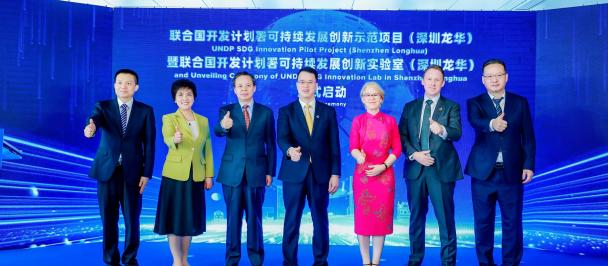UNDP China Resident Representative Beate Trankmann delivers a virtual keynote at the PRI Conference Week: Investing For Net-Zero & SDGs
尊敬的各位来宾,大家下午好。很荣幸能够参加本次PRI的活动。
Ladies and gentlemen, good afternoon!
Humanity is facing code red. We are destroying our planet – the only home that we have. And with every day that passes without decisive action to change this, our chances of averting catastrophe diminishes!
According to the latest IPCC report, we are now on track to overshoot the 1.5 degrees Paris target by more than double. As a consequence, many major cities around the globe including much of China’s financial hub, Shanghai, could be underwater by 2050. As the IPCC warns, it’s “now or never,” to save ourselves.1
We are also in the midst of a biodiversity crisis. 200 species disappear every day – a much faster rate than witnessed at any point over the last 10,000 years2! Their loss also poses severe consequences for our health, food and security – while making it even harder to fight climate change.
Worse still, COVID-19 has also derailed the Sustainable Development Goals to end poverty and protect our planet by 2030, widening the global finance gap to meet them, to 100 trillion USD.3 426 million people have been pushed back into poverty4 as of last year, reversing decades of progress. And – despite the highest global GDP in history – global life expectancy declined, for the second straight year.
Getting back onto a path that allows our earth to sustain everyone, and our society to include everyone, is the most urgent challenge of our times.
If we change course now, we can get there…
…And one of the most vital foundations for that path, is finance.
4.2 trillion USD5 each year is needed to finance the SDGs in developing countries.
That sounds like a lot. But in fact, reallocating just 1.1percent6 of global financial assets would cover it. The problem is not a lack of resources, but of how they are allocated.
To solve this, we must rethink how we invest, and redesign our financial system to make it fit for purpose – so it secures our environment, rather than destroying it – and actually benefits those most vulnerable. This makes business sense. After all, no investment can be sound and lasting in a future of rising climate-linked disasters, resource scarcity and broken social contracts.
Change is possible – and here are three ways to make an immediate turnaround:
First, we need to alter how we perceive risk and opportunities in financial decisions.
By hesitating to invest in sustainable projects and worrying about immediate returns, we lose sight of the real risk – a growing pile of stranded assets.
Increasingly frequent natural disasters, evolving environmental policies and disruptive energy transition technologies mean carbon-intensive and polluting assets are nose-diving in value. Indeed, the IPCC estimates that under a 2 degree global warming scenario, approximately 4 trillion USD worth of fossil fuels and related infrastructure will be stranded7.
On the flip side, sustainable investments means investing in the future, and growth.
Achieving the SDGs by 2030 opens 12 trillion USD of global business opportunities, with 55 percent in Asia.8
By prioritizing nature, businesses could unlock 10 trillion dollars in opportunities globally and create 395 million jobs by 2030.9
To help investors seize these opportunities, UNDP developed the SDG Investor Maps. This bridges the information gap between industries and investors, by identifying investments that can generate both SDG impact and financial returns. They cover numerous industries across 15 countries, including China. Our focus here is on four key sectors: health, agriculture, renewable energy and the circular economy. Using AI, our maps collect and scan thousands of policy documents and business cases, to find where development needs, policy priorities and business potential meet. And we encourage you all to use them.
Second, we must accelerate financial innovation to fund a sustainable future.
In 2020, thanks to new innovative financial instruments, including sustainability-linked bonds and loans, the global sustainability bond market jumped eightfold from the previous year.
Scaling up financial innovation and tools is key for mainstreaming SDG-aligned returns.
In 2021, UNDP supported the New Development Bank in piloting China’s first SDG bond. Using UNDP’s SDG Impact Standards and SDG Finance Taxonomy, NDB issued 5 billion RMB in SDG bonds to support China’s COVID-19 recovery, with the SDG objective of ‘leaving no-one behind’.
We stand ready to continue the cooperation with NDB, and invite more financial institutions to join us in leveraging financial innovation to meet the SDGs.
Third, we must ensure that the shift to a nature-positive economy includes those most vulnerable in that transition.
This includes coal miners, traditional industry workers and communities relying on heavily-polluting sectors. Companies, investors, governments and civil society are all responsible for protecting them.
This could involve retraining people where possible, and offering insurance where it is not. Governments can also support investors in restructuring hard-to-change sectors.
I’m glad to see that the importance of a “just transition” taking center-stage in today’s parallel session.
Enabling a people-centered, green transition is where we believe UNDP has a unique role to play. We have already initiated policy research in this area, including with Dr. Yang Fuqiang’s team at Peking University’s Institute of Energy, who will speak on this topic later in the session. And, we welcome more collaborations to explore how finance can empower a green, inclusive recovery.
On behalf of UNDP, I thank our hosts – the PRI - for inviting us to support this important event, together with the Insurance Asset Management Association of China and the Green Finance Committee of China Society for Finance and Banking.
We have just 8 years left to meet the SDGs – our best chance at survival.
Working together and combining the knowledge, tools and resources we already have, we can succeed.
The one thing we do not have, is time. So we must act today. Thank you!

 Locations
Locations




